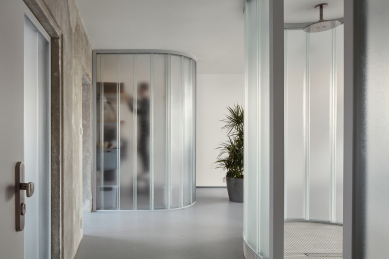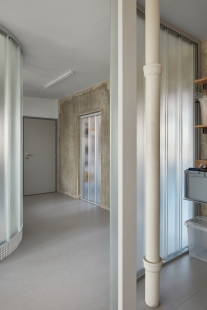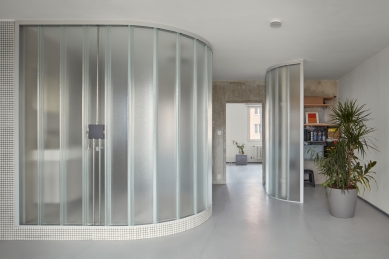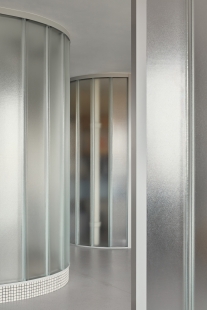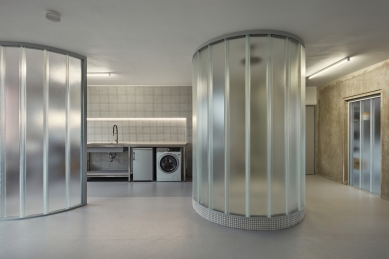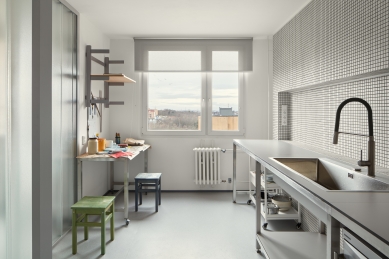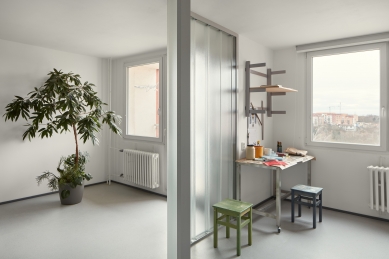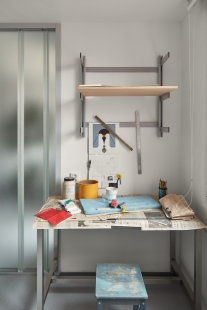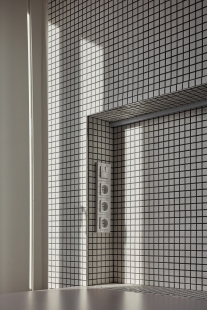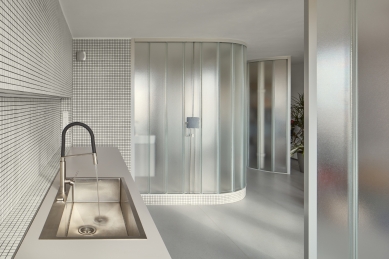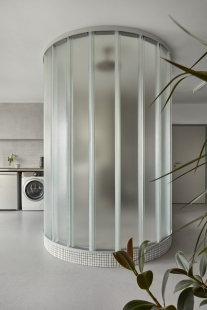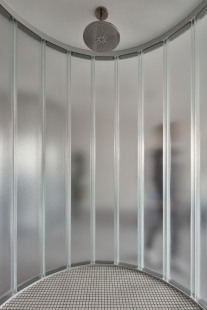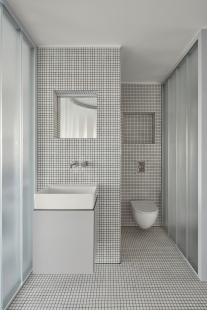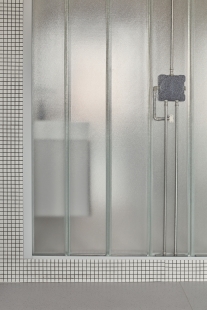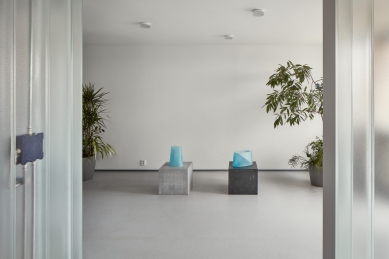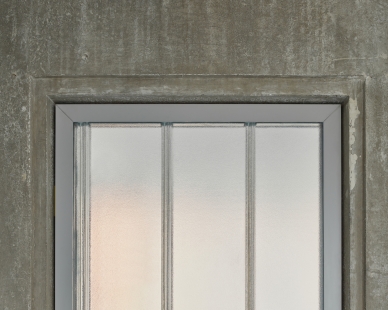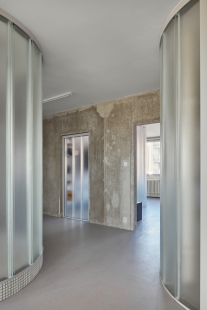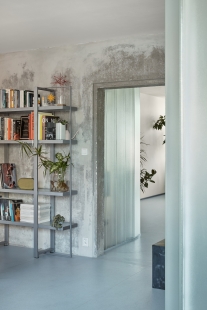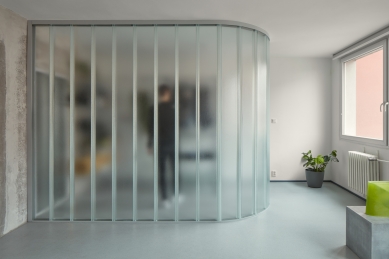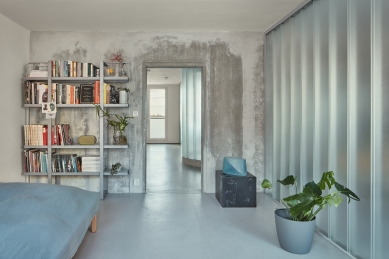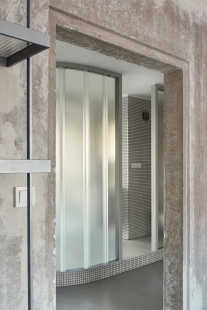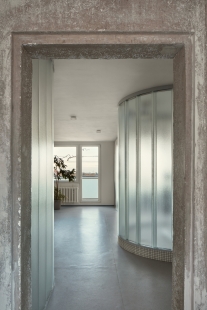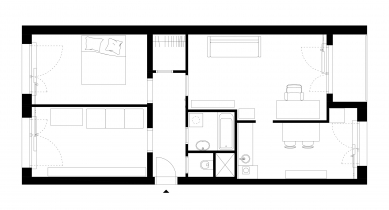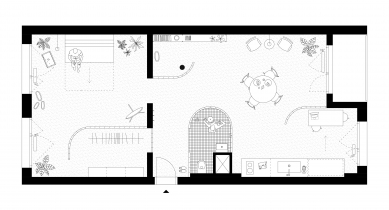
House of the sculptor

Sculptor and glassmaker Vladimír Bachorík has always worked in his apartment in a Prague housing estate – that’s why, during a total renovation, he wanted to design a glass workshop as well. What he did not want, however, were doors. This unusual request has valuable potential to generate unconventional solutions, which we decided to utilize for an experiment: what are the maximum possibilities of a classic apartment block? How far can one go?
Our goal was to employ a hybrid typology and achieve the highest possible degree of freedom, lightness, and generosity. There is a spatial and material dissolution of boundaries and functions: an entirely open and flowing space without doors is divided only by curved semi-partitions made of copilit. These translucent high-order glass blocks ensure the penetration of light. Their materiality and character naturally refer to the lifelong work of the client.
A key limitation for the design, besides the statics, is the infrastructure. The neuralgic point thus becomes the connection of water and sewage, which defines the placement of the only - almost - closed space. The most prominent element is therefore the bathroom arch with a toilet and shower. Due to the waste piping, it is set on a discreet platform that subtly underscores its spatial dominance. The floor plan composition is complemented by three open copilit "hockey sticks" that non-invasively define the wardrobe, storage, and workshop, in other words, the kitchen. The remaining space is freely modulated between these curves of glass and remains open to any future interpretation. We work with our favorite principle, where a unified and unambiguous space provides a background for the life (in this case, primarily the creation) of its occupant. We also work with our second favorite principle, where we remove everything that is not supportive and does not violate the law.
The rectangular floor plan "from window to window" is intersected by a reinforced concrete load-bearing wall with two openings, which we (due to its privileged position) have cleaned to its material essence and made it a bearer of the identity of the place. The remaining walls and ceiling, on the other hand, are left in a lapidary white plaster – we do not wish to overdo the concrete mannerism, nor do we want to compete too much with elegant glass or create a space that is too confined. Areas where there is contact with water are defined by a dirty white mosaic. The generous kitchen, where more objects are created than meals, is formulated in a technical language to functionally meet its primary purpose. The character of the individual spaces is emphasized by the type of lighting used: strict lines or relaxed spotlights.
Our goal was to employ a hybrid typology and achieve the highest possible degree of freedom, lightness, and generosity. There is a spatial and material dissolution of boundaries and functions: an entirely open and flowing space without doors is divided only by curved semi-partitions made of copilit. These translucent high-order glass blocks ensure the penetration of light. Their materiality and character naturally refer to the lifelong work of the client.
A key limitation for the design, besides the statics, is the infrastructure. The neuralgic point thus becomes the connection of water and sewage, which defines the placement of the only - almost - closed space. The most prominent element is therefore the bathroom arch with a toilet and shower. Due to the waste piping, it is set on a discreet platform that subtly underscores its spatial dominance. The floor plan composition is complemented by three open copilit "hockey sticks" that non-invasively define the wardrobe, storage, and workshop, in other words, the kitchen. The remaining space is freely modulated between these curves of glass and remains open to any future interpretation. We work with our favorite principle, where a unified and unambiguous space provides a background for the life (in this case, primarily the creation) of its occupant. We also work with our second favorite principle, where we remove everything that is not supportive and does not violate the law.
The rectangular floor plan "from window to window" is intersected by a reinforced concrete load-bearing wall with two openings, which we (due to its privileged position) have cleaned to its material essence and made it a bearer of the identity of the place. The remaining walls and ceiling, on the other hand, are left in a lapidary white plaster – we do not wish to overdo the concrete mannerism, nor do we want to compete too much with elegant glass or create a space that is too confined. Areas where there is contact with water are defined by a dirty white mosaic. The generous kitchen, where more objects are created than meals, is formulated in a technical language to functionally meet its primary purpose. The character of the individual spaces is emphasized by the type of lighting used: strict lines or relaxed spotlights.
The English translation is powered by AI tool. Switch to Czech to view the original text source.
2 comments
add comment
Subject
Author
Date
Byt
Miguel Ángel ARANDA Ch.
15.11.23 03:31
Svod dešťové vody
Ondřej Tomický
28.12.24 12:34
show all comments


